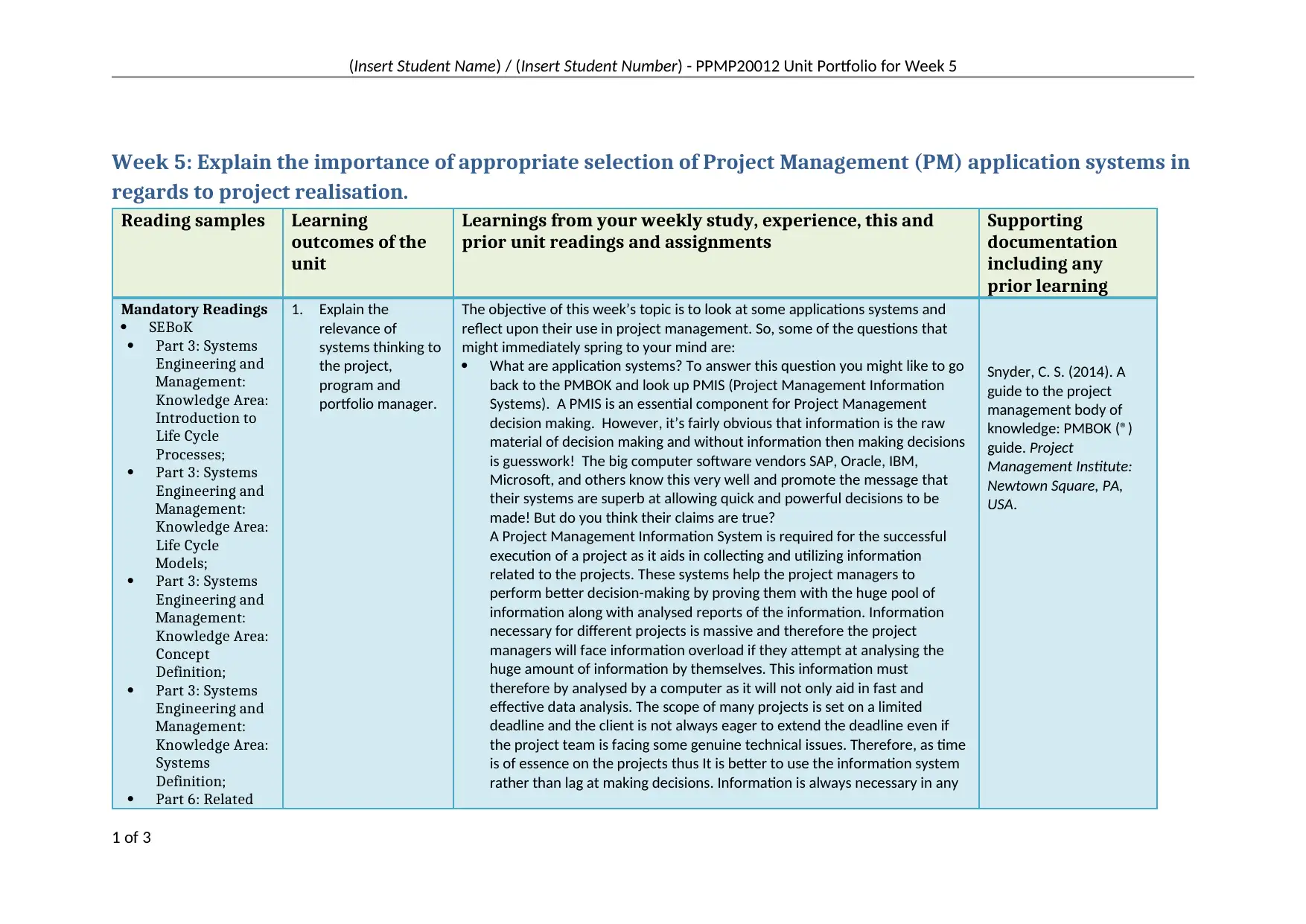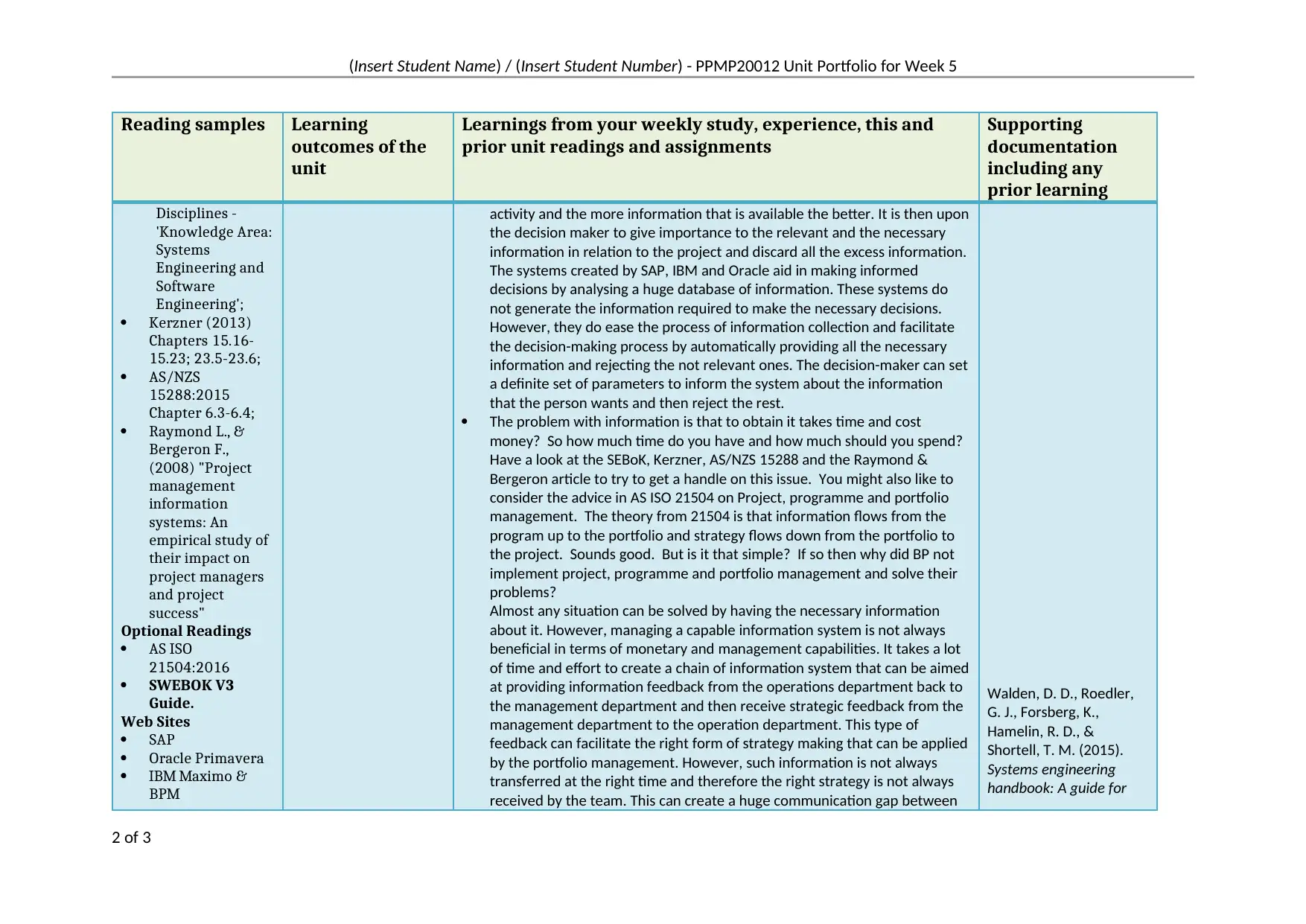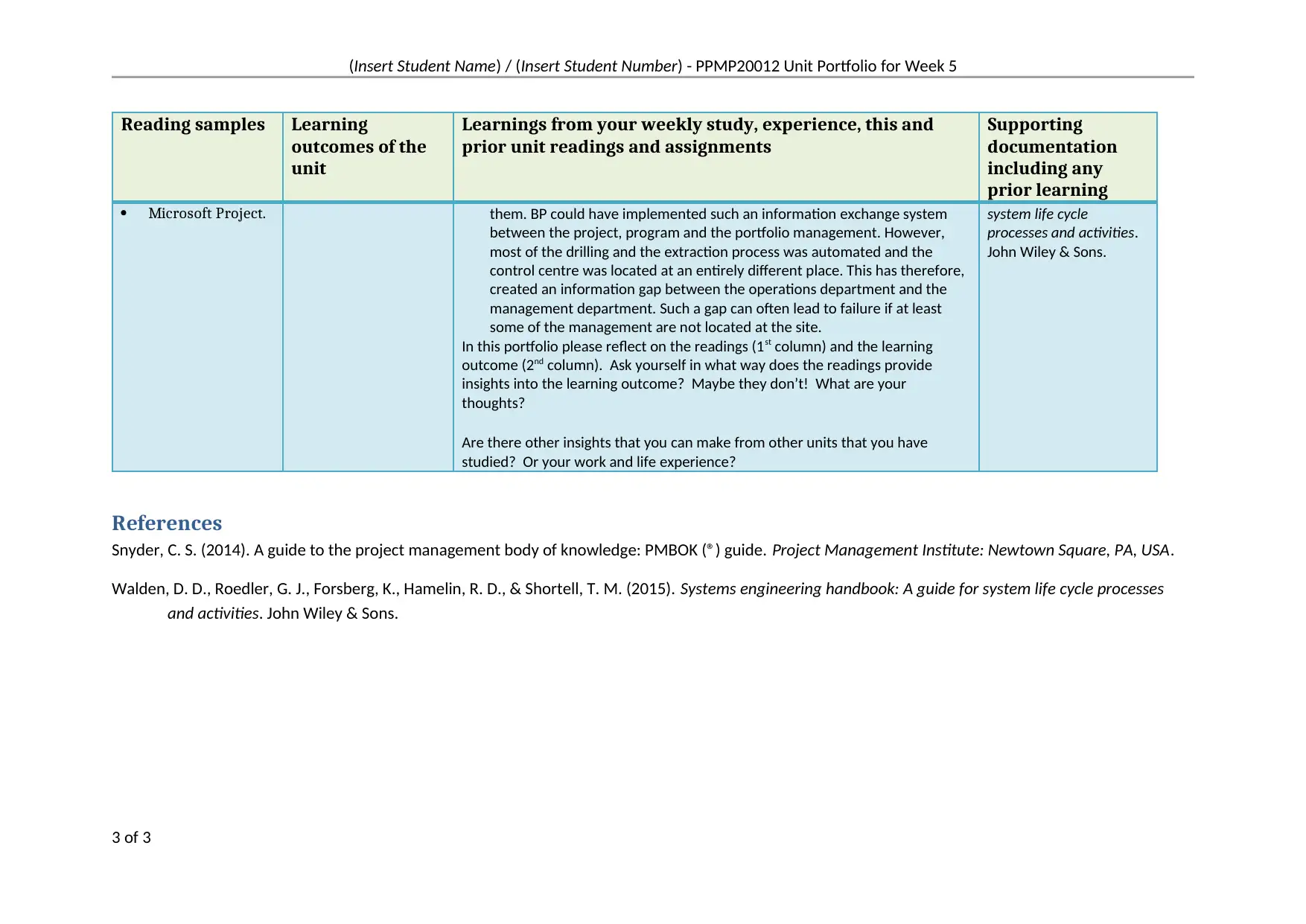PPMP20012 Unit Portfolio - Importance of PM Application Systems
VerifiedAdded on 2021/04/24
|3
|1266
|27
Homework Assignment
AI Summary
This assignment, part of the PPMP20012 unit portfolio for Week 5, focuses on the significance of appropriate selection of Project Management (PM) application systems in achieving successful project realisation. The assignment delves into the concept of Project Management Information Systems (PMIS) and their role in project management decision-making. It explores the advantages of using PMIS, such as efficient data analysis and informed decision-making, and touches upon the importance of systems thinking for project, program, and portfolio managers. The assignment reflects upon the provided readings, including SEBoK, Kerzner, and AS/NZS 15288, and encourages reflection on how these readings provide insights into the learning outcomes. The assignment also highlights the importance of information flow within an organization and the potential pitfalls of inadequate information systems, using BP as a case study. The student is encouraged to reflect on the readings and their own experiences to gain a comprehensive understanding of the topic.

(Insert Student Name) / (Insert Student Number) - PPMP20012 Unit Portfolio for Week 5
Week 5: Explain the importance of appropriate selection of Project Management (PM) application systems in
regards to project realisation.
Reading samples Learning
outcomes of the
unit
Learnings from your weekly study, experience, this and
prior unit readings and assignments
Supporting
documentation
including any
prior learning
Mandatory Readings
SEBoK
Part 3: Systems
Engineering and
Management:
Knowledge Area:
Introduction to
Life Cycle
Processes;
Part 3: Systems
Engineering and
Management:
Knowledge Area:
Life Cycle
Models;
Part 3: Systems
Engineering and
Management:
Knowledge Area:
Concept
Definition;
Part 3: Systems
Engineering and
Management:
Knowledge Area:
Systems
Definition;
Part 6: Related
1. Explain the
relevance of
systems thinking to
the project,
program and
portfolio manager.
The objective of this week’s topic is to look at some applications systems and
reflect upon their use in project management. So, some of the questions that
might immediately spring to your mind are:
What are application systems? To answer this question you might like to go
back to the PMBOK and look up PMIS (Project Management Information
Systems). A PMIS is an essential component for Project Management
decision making. However, it’s fairly obvious that information is the raw
material of decision making and without information then making decisions
is guesswork! The big computer software vendors SAP, Oracle, IBM,
Microsoft, and others know this very well and promote the message that
their systems are superb at allowing quick and powerful decisions to be
made! But do you think their claims are true?
A Project Management Information System is required for the successful
execution of a project as it aids in collecting and utilizing information
related to the projects. These systems help the project managers to
perform better decision-making by proving them with the huge pool of
information along with analysed reports of the information. Information
necessary for different projects is massive and therefore the project
managers will face information overload if they attempt at analysing the
huge amount of information by themselves. This information must
therefore by analysed by a computer as it will not only aid in fast and
effective data analysis. The scope of many projects is set on a limited
deadline and the client is not always eager to extend the deadline even if
the project team is facing some genuine technical issues. Therefore, as time
is of essence on the projects thus It is better to use the information system
rather than lag at making decisions. Information is always necessary in any
Snyder, C. S. (2014). A
guide to the project
management body of
knowledge: PMBOK (®)
guide. Project
Management Institute:
Newtown Square, PA,
USA.
1 of 3
Week 5: Explain the importance of appropriate selection of Project Management (PM) application systems in
regards to project realisation.
Reading samples Learning
outcomes of the
unit
Learnings from your weekly study, experience, this and
prior unit readings and assignments
Supporting
documentation
including any
prior learning
Mandatory Readings
SEBoK
Part 3: Systems
Engineering and
Management:
Knowledge Area:
Introduction to
Life Cycle
Processes;
Part 3: Systems
Engineering and
Management:
Knowledge Area:
Life Cycle
Models;
Part 3: Systems
Engineering and
Management:
Knowledge Area:
Concept
Definition;
Part 3: Systems
Engineering and
Management:
Knowledge Area:
Systems
Definition;
Part 6: Related
1. Explain the
relevance of
systems thinking to
the project,
program and
portfolio manager.
The objective of this week’s topic is to look at some applications systems and
reflect upon their use in project management. So, some of the questions that
might immediately spring to your mind are:
What are application systems? To answer this question you might like to go
back to the PMBOK and look up PMIS (Project Management Information
Systems). A PMIS is an essential component for Project Management
decision making. However, it’s fairly obvious that information is the raw
material of decision making and without information then making decisions
is guesswork! The big computer software vendors SAP, Oracle, IBM,
Microsoft, and others know this very well and promote the message that
their systems are superb at allowing quick and powerful decisions to be
made! But do you think their claims are true?
A Project Management Information System is required for the successful
execution of a project as it aids in collecting and utilizing information
related to the projects. These systems help the project managers to
perform better decision-making by proving them with the huge pool of
information along with analysed reports of the information. Information
necessary for different projects is massive and therefore the project
managers will face information overload if they attempt at analysing the
huge amount of information by themselves. This information must
therefore by analysed by a computer as it will not only aid in fast and
effective data analysis. The scope of many projects is set on a limited
deadline and the client is not always eager to extend the deadline even if
the project team is facing some genuine technical issues. Therefore, as time
is of essence on the projects thus It is better to use the information system
rather than lag at making decisions. Information is always necessary in any
Snyder, C. S. (2014). A
guide to the project
management body of
knowledge: PMBOK (®)
guide. Project
Management Institute:
Newtown Square, PA,
USA.
1 of 3
Paraphrase This Document
Need a fresh take? Get an instant paraphrase of this document with our AI Paraphraser

(Insert Student Name) / (Insert Student Number) - PPMP20012 Unit Portfolio for Week 5
Reading samples Learning
outcomes of the
unit
Learnings from your weekly study, experience, this and
prior unit readings and assignments
Supporting
documentation
including any
prior learning
Disciplines -
'Knowledge Area:
Systems
Engineering and
Software
Engineering';
Kerzner (2013)
Chapters 15.16-
15.23; 23.5-23.6;
AS/NZS
15288:2015
Chapter 6.3-6.4;
Raymond L., &
Bergeron F.,
(2008) "Project
management
information
systems: An
empirical study of
their impact on
project managers
and project
success"
Optional Readings
AS ISO
21504:2016
SWEBOK V3
Guide.
Web Sites
SAP
Oracle Primavera
IBM Maximo &
BPM
activity and the more information that is available the better. It is then upon
the decision maker to give importance to the relevant and the necessary
information in relation to the project and discard all the excess information.
The systems created by SAP, IBM and Oracle aid in making informed
decisions by analysing a huge database of information. These systems do
not generate the information required to make the necessary decisions.
However, they do ease the process of information collection and facilitate
the decision-making process by automatically providing all the necessary
information and rejecting the not relevant ones. The decision-maker can set
a definite set of parameters to inform the system about the information
that the person wants and then reject the rest.
The problem with information is that to obtain it takes time and cost
money? So how much time do you have and how much should you spend?
Have a look at the SEBoK, Kerzner, AS/NZS 15288 and the Raymond &
Bergeron article to try to get a handle on this issue. You might also like to
consider the advice in AS ISO 21504 on Project, programme and portfolio
management. The theory from 21504 is that information flows from the
program up to the portfolio and strategy flows down from the portfolio to
the project. Sounds good. But is it that simple? If so then why did BP not
implement project, programme and portfolio management and solve their
problems?
Almost any situation can be solved by having the necessary information
about it. However, managing a capable information system is not always
beneficial in terms of monetary and management capabilities. It takes a lot
of time and effort to create a chain of information system that can be aimed
at providing information feedback from the operations department back to
the management department and then receive strategic feedback from the
management department to the operation department. This type of
feedback can facilitate the right form of strategy making that can be applied
by the portfolio management. However, such information is not always
transferred at the right time and therefore the right strategy is not always
received by the team. This can create a huge communication gap between
Walden, D. D., Roedler,
G. J., Forsberg, K.,
Hamelin, R. D., &
Shortell, T. M. (2015).
Systems engineering
handbook: A guide for
2 of 3
Reading samples Learning
outcomes of the
unit
Learnings from your weekly study, experience, this and
prior unit readings and assignments
Supporting
documentation
including any
prior learning
Disciplines -
'Knowledge Area:
Systems
Engineering and
Software
Engineering';
Kerzner (2013)
Chapters 15.16-
15.23; 23.5-23.6;
AS/NZS
15288:2015
Chapter 6.3-6.4;
Raymond L., &
Bergeron F.,
(2008) "Project
management
information
systems: An
empirical study of
their impact on
project managers
and project
success"
Optional Readings
AS ISO
21504:2016
SWEBOK V3
Guide.
Web Sites
SAP
Oracle Primavera
IBM Maximo &
BPM
activity and the more information that is available the better. It is then upon
the decision maker to give importance to the relevant and the necessary
information in relation to the project and discard all the excess information.
The systems created by SAP, IBM and Oracle aid in making informed
decisions by analysing a huge database of information. These systems do
not generate the information required to make the necessary decisions.
However, they do ease the process of information collection and facilitate
the decision-making process by automatically providing all the necessary
information and rejecting the not relevant ones. The decision-maker can set
a definite set of parameters to inform the system about the information
that the person wants and then reject the rest.
The problem with information is that to obtain it takes time and cost
money? So how much time do you have and how much should you spend?
Have a look at the SEBoK, Kerzner, AS/NZS 15288 and the Raymond &
Bergeron article to try to get a handle on this issue. You might also like to
consider the advice in AS ISO 21504 on Project, programme and portfolio
management. The theory from 21504 is that information flows from the
program up to the portfolio and strategy flows down from the portfolio to
the project. Sounds good. But is it that simple? If so then why did BP not
implement project, programme and portfolio management and solve their
problems?
Almost any situation can be solved by having the necessary information
about it. However, managing a capable information system is not always
beneficial in terms of monetary and management capabilities. It takes a lot
of time and effort to create a chain of information system that can be aimed
at providing information feedback from the operations department back to
the management department and then receive strategic feedback from the
management department to the operation department. This type of
feedback can facilitate the right form of strategy making that can be applied
by the portfolio management. However, such information is not always
transferred at the right time and therefore the right strategy is not always
received by the team. This can create a huge communication gap between
Walden, D. D., Roedler,
G. J., Forsberg, K.,
Hamelin, R. D., &
Shortell, T. M. (2015).
Systems engineering
handbook: A guide for
2 of 3

(Insert Student Name) / (Insert Student Number) - PPMP20012 Unit Portfolio for Week 5
Reading samples Learning
outcomes of the
unit
Learnings from your weekly study, experience, this and
prior unit readings and assignments
Supporting
documentation
including any
prior learning
Microsoft Project. them. BP could have implemented such an information exchange system
between the project, program and the portfolio management. However,
most of the drilling and the extraction process was automated and the
control centre was located at an entirely different place. This has therefore,
created an information gap between the operations department and the
management department. Such a gap can often lead to failure if at least
some of the management are not located at the site.
In this portfolio please reflect on the readings (1st column) and the learning
outcome (2nd column). Ask yourself in what way does the readings provide
insights into the learning outcome? Maybe they don’t! What are your
thoughts?
Are there other insights that you can make from other units that you have
studied? Or your work and life experience?
system life cycle
processes and activities.
John Wiley & Sons.
References
Snyder, C. S. (2014). A guide to the project management body of knowledge: PMBOK (®) guide. Project Management Institute: Newtown Square, PA, USA.
Walden, D. D., Roedler, G. J., Forsberg, K., Hamelin, R. D., & Shortell, T. M. (2015). Systems engineering handbook: A guide for system life cycle processes
and activities. John Wiley & Sons.
3 of 3
Reading samples Learning
outcomes of the
unit
Learnings from your weekly study, experience, this and
prior unit readings and assignments
Supporting
documentation
including any
prior learning
Microsoft Project. them. BP could have implemented such an information exchange system
between the project, program and the portfolio management. However,
most of the drilling and the extraction process was automated and the
control centre was located at an entirely different place. This has therefore,
created an information gap between the operations department and the
management department. Such a gap can often lead to failure if at least
some of the management are not located at the site.
In this portfolio please reflect on the readings (1st column) and the learning
outcome (2nd column). Ask yourself in what way does the readings provide
insights into the learning outcome? Maybe they don’t! What are your
thoughts?
Are there other insights that you can make from other units that you have
studied? Or your work and life experience?
system life cycle
processes and activities.
John Wiley & Sons.
References
Snyder, C. S. (2014). A guide to the project management body of knowledge: PMBOK (®) guide. Project Management Institute: Newtown Square, PA, USA.
Walden, D. D., Roedler, G. J., Forsberg, K., Hamelin, R. D., & Shortell, T. M. (2015). Systems engineering handbook: A guide for system life cycle processes
and activities. John Wiley & Sons.
3 of 3
⊘ This is a preview!⊘
Do you want full access?
Subscribe today to unlock all pages.

Trusted by 1+ million students worldwide
1 out of 3
Related Documents
Your All-in-One AI-Powered Toolkit for Academic Success.
+13062052269
info@desklib.com
Available 24*7 on WhatsApp / Email
![[object Object]](/_next/static/media/star-bottom.7253800d.svg)
Unlock your academic potential
Copyright © 2020–2025 A2Z Services. All Rights Reserved. Developed and managed by ZUCOL.



